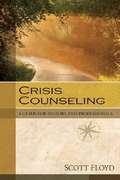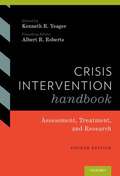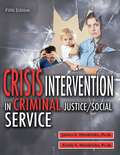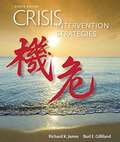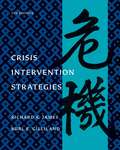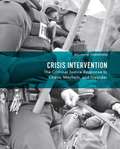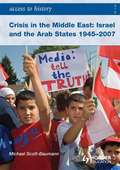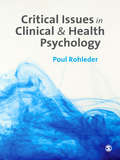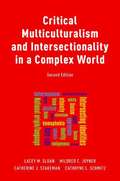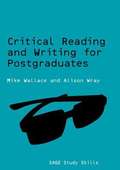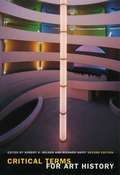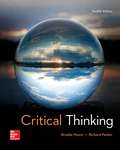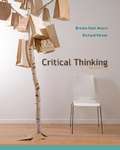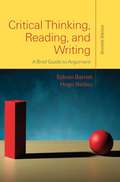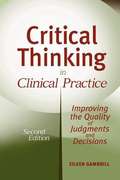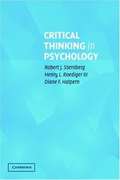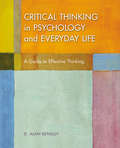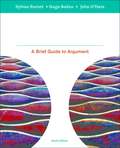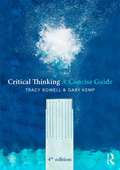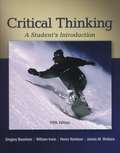- Table View
- List View
Crisis Counseling: A Guide for Pastors and Professionals
by Scott FloydDr. Floyd helps readers understand the nature of crises events, how individuals are impacted, and how to best provide help during and following times of trauma, loss, and grief.
Crisis Intervention Handbook: Assessment, Treatment, and Research (Fourth Edition)
by Kenneth Yeager Albert RobertsFewer concepts in American society have received more attention recently than the need for skilled crisis intervention. Images of crises inundate internet and newspaper headlines, television screens and mobile devices. As a result of the growing amount of acute crisis events portrayed in the media that impact the lives of the general public, interest in crisis intervention, response teams, management, and stabilization has grown tremendously. Skills and methods to effectively manage acute crisis situations are in high demand. While many claim to understand the rapidly growing demand for effective crisis management, few provide clearly outlined step-by-step processes to educate and guide health and mental health professionals. This is a thorough revision of the first complete and authoritative handbook that prepares the crisis counselor for rapid assessment and timely crisis intervention in the 21st century.
Crisis Intervention In Criminal Justice/Social Service (Fifth Edition)
by James E. Hendricks Cindy S. HendricksThis expanded new edition continues to demonstrate and provide theoretical, analytical, and practical knowledge for first responders. Face-to-face interaction with the client/victim is part of the comprehensive approach advocated by the book, which requires interveners to assess the nature of a crisis and the condition of the victim in order to determine the appropriate course of action. The comprehensive balance of theory and practice presented in this book should enable the intervener in coupling his/her general knowledge of human psychology and emotional crisis with the specific and novel characteristics of various crisis situations. The text represents the work of national scholars who have expertise in criminal justice and social service issues. Their chapters focus on a Historical and Theoretical Overview, Ethics in Crisis Intervention Practice, Intimate Partner Violence, Police Response to Domestic Violence, Children in Crisis, Elder Mistreatment, Suicide, Crisis of Rape and Survivor Intervention, Death Notification and the Theory and Practice of Delivering Bad News, Terrorism and Crisis Intervention, and Mass Casualty Crisis Response and Communication. Helpful appendices in each chapter provide additional internet resources, as well as a complete Model Law Enforcement Code of Ethics and Social Work Code of Ethics. This new edition retains important information while providing current case studies such as the "Miracle on the Hudson River" crash, the mass shootings at Virginia Tech, the Boston Marathon bombing, and the Yarnell Hill fire in Arizona. This exceptional book is designed for firefighters, police officers, community service officers, correctional workers, emergency medical workers, probation/parole officers, protective service workers, psychological counselors, social workers, and victim assistance workers among others.
Crisis Intervention Strategies
by Richard James Burl GillilandThis authoritative, best-selling text presents the latest skills and techniques for handling crisis situations. <p><p>The authors' task model clearly illustrates and elucidates the process of dealing with people in crisis, from defining the problem to obtaining commitment. Using this model, the authors build specific strategies for handling a myriad of different crisis situations, accompanied in many cases with the dialogue that a practitioner might use when working with the individual in crisis. This book puts you on the front lines with the crisis worker throughout the chapters, and then illuminates the techniques and strategies the worker used. <p><p>New videos in MindTap (available with the text) correlate with the text and demonstrate crisis intervention techniques, ensuring that you not only understand the theoretical underpinnings of crisis intervention theories, but also know how to apply them in crisis situations.
Crisis Intervention Strategies 7th Edition
by Richard K. James Burl E. GillilandThis authoritative, best-selling text presents the latest skills and techniques for handling real crisis situations. The authors' six-step model clearly illustrates and elucidates the process of dealing with people in crisis: Defining the Problem, Ensuring Client Safety, Providing Support, Examining Alternatives, Making Plans, and Obtaining Commitment. Using this model, the authors then build specific strategies for handling a myriad of different crisis situations, accompanied in many cases with the dialogue that a practitioner might use when working with the individual in crisis.
Crisis Intervention: The Criminal Justice Response to Chaos, Mayhem, and Disorder
by William M. Harmening Douglas CraigCrisis Intervention: The Criminal Justice Response to Chaos, Mayhem, and Disorder introduces readers to the methods and techniques of crisis intervention employed by police and correctional officers. Rather than focusing on abstract theories, this text presents real-life situations first and then explores the theories and methods relevant to those situations. It goes beyond the simple presentation of facts and incorporates best practices of policing and other topics usually found only in police training manuals. The text also examines the psychological effects of crisis on criminal justice professionals and ethical considerations related to crisis response.
Crisis at McKinnon's Knob (Fountas & Pinnell Classroom, Guided Reading)
by Jennifer Gillis Alexander WellsNIMAC-sourced textbook. A BAD SITUATION. When two brothers find themselves in a dangerous situation while hiking, they call on survival skills they'd learned and hope those skills will be enough to save them.
Crisis en la montaña (¡Arriba la Lectura!, Level P #23)
by Diana Noonan Trish BowlesNIMAC-sourced textbook
Crisis in the Middle East: Israel and the Arab States, 1945-2007 (Access to History)
by Michael Scott-BaumannThis book explores and analyzes the history of conflict in the Middle East from British rule in the early twentieth century to the Iraq war in the twenty-first century. The Arab-Israeli conflict is the main focus of this book but it also examines: Arab nationalism, especially in Egypt andSyria; the Islamic revolution in Iran in 1979; the causes and consequences of three wars involving Iraq; the growth of political Islam and Islamic fundamentalism in the Middle East. Throughout the book, key dates, terms and issues are highlighted, and historical interpretations of key debates are outlined. Summary diagrams are included to consolidate knowledge and understanding of the period, and exam-style questions and tips written by examiners provide the opportunity todevelop exam skills.
Crisis on the Mountain (Into Reading, Level T #23)
by Diana Noonan Trish BowlesNIMAC-sourced textbook
Critical Issues in Clinical and Health Psychology
by Dr Poul RohlederThis textbook gives a clear and thought-provoking introduction to the critical issues related to health, illness and disability in clinical and health psychology. Challenging some of the preconceptions of ill-health of the biomedical approach, the book explores how health and illness is often shaped by factors such as culture, poverty, gender and sexuality, and examines how these influences impact on the experience and treatment of physical and mental illness as well as disability. Students are introduced to literature from disciplines other than psychology to provide multiple perspectives on these complex issues.<P><P> Critical Issues in Clinical and Health Psychology is a key textbook for undergraduate and postgraduate students taking courses in health or clinical psychology, as well as for students from other disciplines related to health and mental health care.
Critical Multiculturalism and Intersectionality in a Complex World
by Mildred C. Joyner Cathryne L. Schmitz Lacey M. Sloan Catherine J. StakemanCritical Multiculturalism and Intersectionality in a Complex World guides the reader through a process of critical self-reflection that allows for examination of social identities, biases, and experiences of oppression and privilege. Its exploration of the history, sources, mechanisms, structures, and current manifestations of oppression ― complimented by case examples (with new stories from across the globe) and guiding questions ― provides a framework for improving the ability to recognize, confront, and dismantle oppressions. Deeper cultural patterns, implicit biases, and internalized negative perceptions are examined, enabling readers to explore cultures that have different patterns, values, and behaviors while challenging their own biases about 'other' cultures. In addition to a focus on the USA, this edition features added content on Brazil, United Arab Emirates, Canada, South Africa, Australia, India, and Kenya. This new edition will appeal to all graduate and undergraduate students of the social sciences, human sciences, and humanities.
Critical Reading and Writing for Postgraduates
by Mike Wallace Alison Wray'A systematic, coherent approach to developing critical reading and writing skills that are applicable to a range of different levels of analysis and types of reading and writing tasks. The authors are to be commended for the clarity of their writing and the way scaffolded advice and tasks are integrated into the text. The book could form the core text for a course on critical reading and writing and a useful reference tool for the academic recently entered upon writing for publication.' - Educate Journal 'A very clear, accessible introduction that will be invaluable to postgraduate students trying to engage with reading and writing in a critical way' - R.M. Lee, Professor of Social Research Methods, Royal Holloway University of London This guide to critical reading and self-critical writing is a 'must-have' resource for postgraduate students and early-career academics. Packed with tools for analysing texts and structuring critical reviews, and incorporating exercises and worked examples drawn from the social sciences, the book offers step-by-step advice on how to: " read any text critically and analyse it in the depth appropriate to one's project " develop a self-critical approach to one's own academic writing " ask questions in order to evaluate authors' arguments " keep a review manageable by using focused review questions " structure a comparative review of multiple texts " build up a convincing argument " integrate critical literature reviews into a dissertation or thesis " make the transition from postgraduate to professional academic writer Essential reading for novice researchers, the book will also be invaluable for supervisors, methods course tutors, and academic mentors who teach and support the development of critical reading and self-critical writing skills.
Critical Terms for Art History (2nd edition)
by Robert S. Nelson Richard Shiff"Art" has always been contested terrain, whether the object in question is a medieval tapestry or Duchamp's Fountain.
Critical Thinking
by Richard Parker Brooke Noel MooreThe first integrated program designed specifically for the critical thinking course, Moore & Parker's Critical Thinking teaches students the skills they need in order to think for themselves--skills they will call upon in this course, in other college courses, and in the world that awaits. The authors' practical and accessible approach illustrates core concepts with concrete real-world examples, extensive practice exercises, and a thoughtful set of pedagogical features.
Critical Thinking (9th edition)
by Richard Parker Brooke Noel MooreMore than any other textbook, Moore and Parker's Critical Thinking has defined the structure and content of the critical thinking course at colleges and universities across the country--and has done so with a witty writing style that students enjoy. Current examples relevant to today's students bring the concepts of critical thinking to life in vivid detail. This ninth edition offers an abundance of new exercises and examples, as well as a renewed focus on the importance of developing critical thinking skills.
Critical Thinking Reading and Writing: A Brief Guide to Argument (7th edition)
by Sylvan Barnet Hugo BedauCritical Thinking, Reading, and Writing is a compact but complete guide to critical thinking and argumentation. Comprising the text portion of the widely adopted Current Issues and Enduring Questions, it draws on the authors' dual expertise in effective persuasive writing and comprehensive rhetorical strategies to help students move from critical thinking to argumentative and researched writing. With comprehensive coverage of classic and contemporary approaches to argument, including Aristotle, Toulmin, and a range of alternative views, as well as 35 readings and a casebook on the state and the individual, it is an extraordinarily versatile text. This affordable guide can stand alone or supplement a larger anthology of readings.
Critical Thinking in Clinical Practice: Improving the Quality of Judgments and Decisions (2nd edition)
by Eileen GambrillDecisions are influenced by a variety of fallacies and biases that we can learn how to avoid. Critical thinking values, knowledge, and skills, therefore, are integral to evidence-based practice. These emphasize the importance of recognizing ignorance as well as knowledge and the vital role of criticism in discovering how to make better decisions. This book is for clinicians--clinicians who are willing to say "I don't know. " Critical Thinking in Clinical Practice, Second Edition is designed to enhance readers' skills in making well-informed, ethical decisions. Making such decisions is no easy task. Decisions are made in uncertain, changing environments with time pressures. Interested parties, such as the pharmaceutical industry, spend millions of dollars to influence decisions made. Drawing on a wide range of related literature, this book describes common pitfalls in clinical reasoning as well as strategies for avoiding them--sometimes called mind-tools. Mental health and allied professionals will come away from this text with knowledge of how classification decisions, a focus on pathology, and reliance on popularity can cause errors. Hazards involved in data collection and team decision making such as groupthink are discussed. Part 1 provides an overview of the context in which clinicians make decisions. Part 2 describes common sources of error, and Part 3 describes decision aids including the process of evidence-based practice. Part 4 describes the application of related content to different helping phases including assessment, intervention, and evaluation. Part 5 suggests obstacles to making well-informed decisions and how to encourage lifelong learning. This new Second Edition has been completely updated with expanded coverage on: * Evidence-based practice * Screening issues and practice errors * Lifelong learning * Problem solving * Decision making An interactive, dynamic book filled with insightful examples, useful lists and guidelines, and exercises geared to encourage critical thinking, Critical Thinking in Clinical Practice, Second Edition provides an essential resource for helping professionals and students.
Critical Thinking in Psychology
by Robert J. Sternberg Diane F. Halpern Henry L. RoedigerGood scientific research depends on critical thinking at least as much as factual knowledge; psychology is no exception to this rule. And yet, despite the importance of critical thinking, psychology students are rarely taught how to think critically about the theories, methods, and concepts they must use. This book shows students and researchers how to think critically about key topics such as experimental research, statistical inference, case studies, logical fallacies, and ethical judgments.
Critical Thinking in Psychology and Everyday Life: A Guide to Effective Thinking
by D. Alan BensleyCritical Thinking in Psychology and Everyday Life shows how a scientific, critical thinking approach can be effective in addressing psychological questions, and discusses other questions that straddle the boundary between science and non-science. While scientific, critical thinking can be effective in addressing psychological questions, this textbook is a guide for how to separate fact from speculation and true claims from misconceptions and misinformation. Covering a wide range of topics, this book seeks to engage students in a serious search for answers, using what psychologists and other scientists know about how to think effectively. What does science have to say about whether some people have special psychic abilities, such as being able to "see" the future? Can people use their minds to move objects without any physical aid? Does the mind actually leave the body during an out-of-body experience? You may be surprised to learn that we are tantalizingly close to a scientific answer to this last question (see Chapter 7).
Critical Thinking, 4th Edition
by Richard L. Epstein Alex Raffi Michael RooneyWith more than 1,000 everyday examples and exercises, the text engages and challenges the student. It is the only text on critical thinking in which students work with illustrations to convert the nonverbal into arguments and arrive at conceptual understanding.
Critical Thinking, Reading And Writing: A Brief Guide To Argument
by John O'Hara Sylvan Barnet Hugo BedauCritical Thinking, Reading, and Writing is a compact but complete guide to critical thinking and argumentation. Comprising the text portion of the widely adopted Current Issues and Enduring Questions, it draws on the authors’ dual expertise in effective persuasive writing and comprehensive rhetorical strategies to help students move from critical thinking to argumentative and researched writing. With comprehensive coverage of classic and contemporary approaches to argument, including Aristotle, Toulmin, and a range of alternative views, as well as 35 readings and a casebook on the state and the individual, it is an extraordinarily versatile text. This affordable guide can stand alone or supplement a larger anthology of readings.
Critical Thinking: A Concise Guide (4th Edition)
by Tracy Bowell Gary KempWe are frequently confronted with arguments. Arguments are attempts to persuade us #65533; to influence our beliefs and actions #65533; by giving us reasons to believe this or that. Critical Thinking: A Concise Guide will equip students with the concepts and techniques used in the identification, analysis and assessment of arguments. Through precise and accessible discussion, this book provides the tools to become a successful critical thinker, one who can act and believe in accordance with good reasons, and who can articulate and make explicit those reasons. Key topics discussed include: core concepts in argumentation how language can serve to obscure or conceal the real content of arguments; how to distinguish argumentation from rhetoric how to avoid common confusions surrounding words such as #65533;truth#65533;, #65533;knowledge#65533; and #65533;opinion#65533; how to identify and evaluate the most common types of argument how to distinguish good reasoning from bad in terms of deductive validly and induction. This fourth edition has been revised and updated throughout, with a new introduction for each chapter and up-to-date topical examples. Particular revisions include: practical reasoning; understanding quantitative data, statistics, and the rhetoric used about them; scientific reasoning; the connection to formal logic and the logic of probability; conditionals; ambiguity; vagueness; slippery slope arguments; and arguments by analogy. The dynamic Routledge Critical Thinking companion website provides thoroughly updated resources for both instructors and students including new examples and case studies, flashcards, sample questions, practice questions and answers, student activities and a testbank of questions for use in the classroom.
Critical Thinking: A Student's Introduction (Fifth Edition)
by William Irwin Gregory Bassham Henry Nardone James WallaceBassham's popular text helps today's students bridge the gap between everyday culture and critical thinking. Using a proven step-by-step approach, this text covers all the basics of critical thinking in clear, reader-friendly language. The 5th edition has taken into account suggestions from users and reviewers of previous editions, and has added an Appendix, and new readings, exercises and examples throughout the text.
Critical Thinking: Learn The Tools The Best Thinkers Use
by Richard Paul Linda ElderWritten by two of the leading experts in critical thinking, this book focuses on an integrated, universal concept of critical thinking that is both substantive and applicable to any and every situation in which human thinking is necessary. It provides readerse with the basic intellectual tools needed for life-long learning, helping them understand the mind and how its three functions — thinking, feeling, motivation — influence and are influenced by one another. This book fosters the development of fair-minded critical thinking. Features the intellectual standards: clarity, precision, accuracy, logicalness, significance, depth, breadth, and fairness; The importance of good questioning; and intellectual tools to read for deep and lasting comprehension, and to write in ways that show clarity of reasonability of thought. For all that want to improve their critical thinking skills to apply to their job or life.
